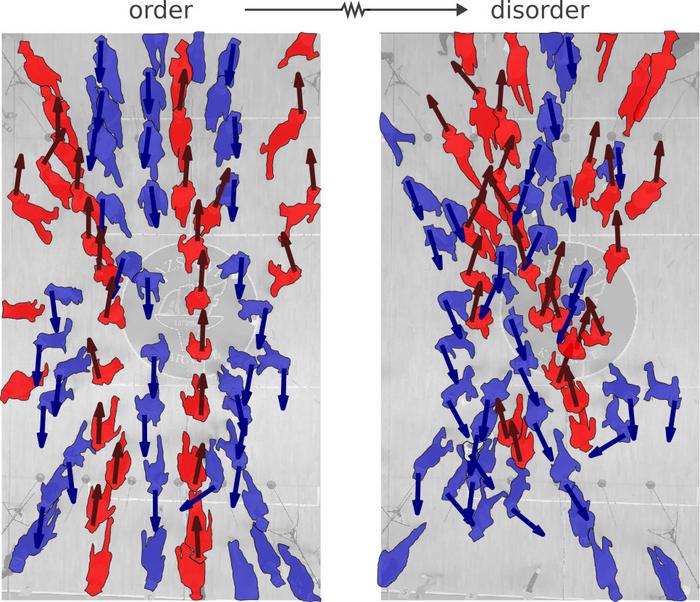Pedestrian crossings are often seen as epitomes of orderly human behavior, where individuals seamlessly flow in organized lanes, effectively moving towards their destinations. However, this ideal can quickly devolve into chaos, with pedestrians navigating erratically through congestion. A groundbreaking study led by an international team of mathematicians, with contributions from Professor Tim Rogers at the University of Bath and Dr. Karol Bacik at MIT, has revealed critical insights into the dynamics of pedestrian flow. This research not only enhances our understanding of pedestrian behavior but also offers practical applications for urban planning aimed at reducing chaos and improving safety in crowded spaces.
The study, published in the esteemed journal Proceedings of the National Academy of Sciences, elucidates the conditions under which pedestrian flow transitions from orderly to disordered. The researchers pinpointed a specific threshold: a critical angle of 13 degrees. When pedestrians deviate from linear paths by more than this angle, the orderly lanes disintegrate, leading to a disorganized and slow-moving crowd. This discovery has profound implications for urban designers and planners, who can use these findings to create safer and more efficient pedestrian environments.
To reach this conclusion, the researchers employed a dual approach. They conducted mathematical simulations based on principles akin to those used in fluid dynamics, modeling pedestrian behavior much like molecules in a fluid. This theoretical framework allowed them to explore various angles of crossing and the intricate dodging maneuvers individuals make to avoid collisions while attempting to reach their destinations. The mathematical model predicted that increased deviation from straight paths significantly decreases the likelihood of orderly lane formation, aligning closely with observations from real-world pedestrian dynamics.
Empirical evidence supporting this model was obtained through meticulous controlled crowd experiments. In these experiments, participants were directed to cross a simulated pedestrian intersection while avoiding bumps and collisions. By varying their starting and ending points, the researchers gathered extensive data revealing detailed patterns of pedestrian movement. The results confirmed their mathematical predictions: as the angle of deviation increased beyond the critical threshold, the organized flow gave way to chaos and confusion.
Interestingly, the researchers found that the correlation between crowd order and pedestrian speed was significant; as disorder increased, the overall speed of pedestrian movement decreased. This insight holds practical value for urban planners who can leverage such findings to optimize the design of pedestrian crossings and thoroughfares. For instance, narrower crossings could discourage veering and help maintain order, while strategic placement of crossings could guide pedestrian flow more effectively.
Professor Rogers emphasized the importance of their findings in understanding the spontaneous formation of lanes in crowded environments. He noted that when a crowd begins to manifest an organized lane, pedestrians naturally gravitate towards it, reinforcing the lane’s formation through collective behavior. This observation underscores the significance of spatial design in encouraging efficient pedestrian flow.
As both theoretical and practical frameworks continue to evolve, the implications of this research extend beyond simple crowd dynamics. The study opens avenues for refining urban infrastructure to enhance pedestrian safety, streamline movement, and reduce the risk of accidents. By utilizing proven mathematical models and experimental validations, city planners can design public spaces equipped to handle high volumes of foot traffic in an organized manner.
In future research, the team plans to explore the application of their findings in bustling urban environments, where pedestrian dynamics can be complex. Real-world testing in busy cities could validate their theoretical predictions and provide deeper insights into how spatial variations affect crowd behavior. This forward-thinking approach reinforces the significance of interdisciplinary research, marrying theory with practice to address real-world challenges.
Overall, the groundbreaking findings from this research not only contribute to our understanding of pedestrian behavior but also equip urban planners and designers with the tools necessary to enhance public safety and efficiency. The investigation deepens the relationship between mathematical modeling and practical application, highlighting the critical need for informed design in bustling urban spaces. As cities grow and pedestrian traffic increases, these insights become ever more vital in fostering orderly and safe environments for all.
The meticulous nature of this research, melding theory with hands-on experimentation, serves as a robust example of how mathematical principles can be employed to address everyday challenges. With urban areas becoming increasingly congested, understanding the chaotic patterns of human movement offers a pathway to better-designed spaces that prioritize pedestrian safety and traffic flow.
By examining pedestrian interactions and the critical conditions for maintaining orderly flow, this study ultimately reveals a pathway toward designing effective and efficient public spaces that not only facilitate movement but enhance the overall pedestrian experience. As researchers move forward with their inquiry, the integration of predictive modeling and empirical study will continue to shape our understanding of pedestrian dynamics in complex environments.
The evolving landscape of pedestrian infrastructure demands innovative solutions rooted in rigorous research. This study stands as a testament to the power of academic inquiry in addressing real-world issues, paving the way for a future where safe and efficient pedestrian movement is a standard rather than an exception.
Subject of Research: People
Article Title: Order-disorder transition in multidirectional crowds
News Publication Date: 24-Mar-2025
Web References:
References:
Image Credits: Karol Bacik, MIT
Keywords: pedestrian behavior, crowd dynamics, urban planning, mathematical modeling, safety, pedestrian flow, orderly lanes, chaos, fluid dynamics, interdisciplinary research, public space design, empirical study, real-world application.




